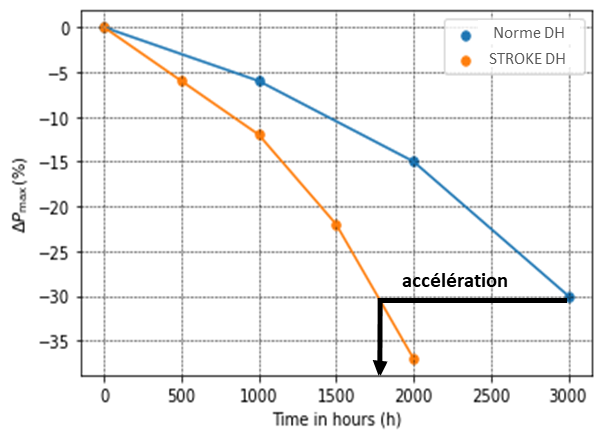Thanks to a sequence of reinforced tests, the STROKE method makes it possible to probe certain effects that cannot be revealed by the current standards in a reduced time.

STROKE accelerates the ageing of solar panels to improve their reliability
[ITE INES.2S]
The durability/reliability of photovoltaic panels is an economic and environmental issue. They must be resistant at least 25 years of operation, subject to external conditions.
The IEC 61215 standard defines the tests that should make it possible to identify the least robust panels. However, these tests are currently considered insufficient to test the reliability of panels. As a result, most research centers and companies carry out reinforced tests, doubling or tripling the standard’s requirements, which is both costly and lengthens development times.
Within the framework of the ITE INES.2S, the CEA is developing at INES an accelerated-combined ageing method, called STROKE, which makes it possible to reveal the degradation mechanisms of photovoltaic modules by limiting the duration and number of tests.
A series of tests on commercial references representative of current products on the market has validated the approach. The study allowed the tests required by the standard to be applied to the panels and, in parallel, the CEA's accelerated-combined ageing method to be used in order to compare the time taken for performance losses and associated degradation to appear. The results show a significant time saving on humidity, UV and thermal cycling tests.
The objective of increasing the stress levels of each test is to reduce the time required to identify a degradation mode (see illustration on the DH test example) or to strengthen a test whose level is too low.
The results demonstrate the acceleration of the degradation mechanisms by applying the STROKE method. With a total duration of 90 days, instead of 6 months, to carry out this accelerated/combined ageing sequence, the time saving becomes significant and highlights the degradation mechanisms; a causal link based on Arrhenius' law and the activation energy of polymer materials thus revealing the most impacting factors.
The method will be further developed with a larger number of references in the coming months.

What tests are typically performed to test the reliability of photovoltaic panels?
- The Dynamic Mechanical Load test simulates the mechanical stresses experienced by the panels during transport, installation, etc. It can reveal cracks in the cells and the degradation of faulty interconnections because of these mechanical stresses.
- Damp Heat tests are designed to reveal the sensitivity of the panels to humidity.
- UV aging tests are used to demonstrate the sensitivity of cells, encapsulants or polymer films for adhesion and module interconnections to UV irradiation. Various degradations can be observed, such as cell discoloration or yellowing of the encapsulants.
- The Temperature Cycle test simulates the thermal cycles that modules are exposed to in real-life conditions through day/night cycles. These temperature cycles are accelerated in an environmental chamber in order to demonstrate their effects on the panels. The most common modes of degradation observed because of these tests are interconnection degradation and module delamination.
- The Humidity Freeze test can show cell and interconnection corrosion and module delamination.
Launched in 2019, INES.2S is an Institute for Energy Transition (ITE). Led by the CEA at INES, its mission is to develop an industrial sector for the integration of photovoltaic solar energy in France, in support of the French Multiannual Energy Programming Act. The ITE INES.2S is co-financed by the French government under the Programme d'Investissements d'Avenir (ANR-10-IEED-0014-01).